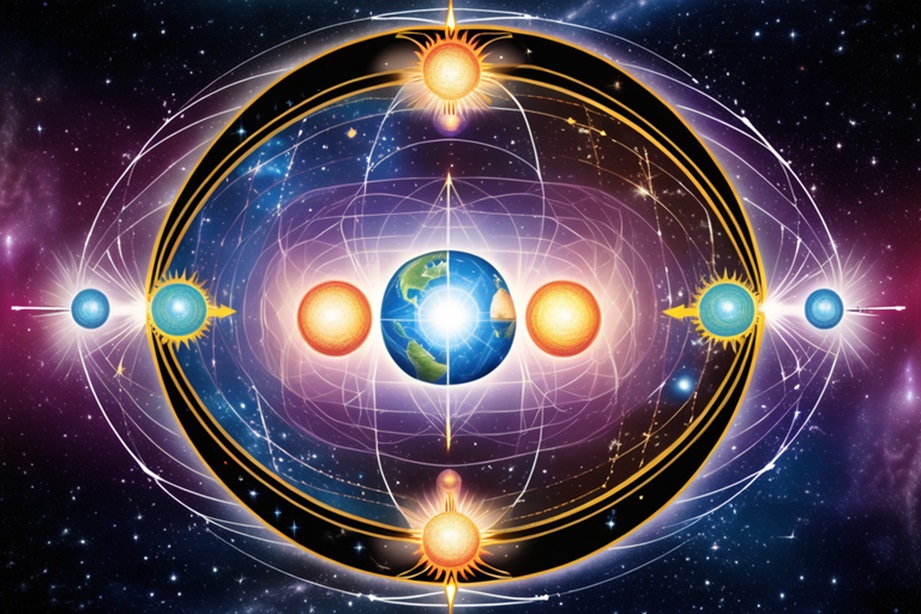The world that is made up of our literal descriptions is a null world. To have literal descriptions might seem useful to us, convenient for us, but there’s absolutely nothing useful or helpful about the Nullity! The Nullity is bad news all around…
There’s nothing good that we can say about the Nullity – it’s still not that kind of a thing. The Nullity operates by offering us the possibility of something that we find extremely attractive, extremely exciting, and then – when we’re hooked, when we’re sold on whatever it is (when we’ve bought into the package) it lets us down, it disappoints us. The greater our anticipation, the more intense our excitement, the harder we are going to take the ‘let down’ phase.
The Nullity is composed of euphoria and dysphoria in equal amounts, we might say. It’s ‘six of one and half a dozen of the other’. The Nullity ‘gives with one hand and takes away with the other’, only it isn’t actually giving us anything really – it says that it will, but then it doesn’t. It’s ‘making a promise and then breaking it’. It is asserting something and then revealing in the fullness of time that what was stated so authoritatively (so very convincingly) was actually a total lie!
The Nullity is a ‘YES/NO Machine’, in other words. We get all fired up by the YES, only to have all our hopes cruelly dashed with the next turn of the wheel. We get euphorically excited by the YES and dysphorically excited by the NO, and yet there’s no way to have a YES without also having a NO. That can’t be done. The NO can’t be separated from the YES because the YES is the NO. A thing can’t be separated from itself.
We know nothing about the Nullity, however, and if someone were to try to explain it to us we just wouldn’t get it. We’ve got a blank about it. We have – over the last hundred years or so – developed a whole system of psychology that never once mentions that YES equals NO. It’s not just that no one ever mentions it either – the body of psychological ‘knowledge’ that we have put together implicitly denies that positive is the same as thing as negative; the body of knowledge that we have put together is predicated upon the assumption that PLUS doesn’t equal MINUS, that YES isn’t the same as NO.
Everything thought does is based on the premise that ‘YES doesn’t equal NO’, obviously. This is what Jung refers to as ‘one-sidedness’ – we can only ever see one side at a time. All the structures of thought rely on our one-sided way of seeing the world; were we to stop being one-sided then the illusion of there being a structure, the illusion of there being a system, would vanish very smartly. ‘To cross twice is not to cross,’ says Spencer-Brown in his Laws of Form. If an event is reversed later on then this means that there was no event – it means that what I took to be an event was actually a Null Event. If I say YES first but then contradict myself later on then I haven’t said anything…
No one never talks about the Nullity – it doesn’t get any airtime anywhere. not even on the pirate stations. Instead, we universally act as if only the first part of the ‘YES/NO Machine’ exists; we act as if the positive assertion that thought makes isn’t going to be cancelled out later on. We act as if the world that is constructed out of our literal descriptions isn’t going to be reversed later on; crucially, we act as if the literal conception of ourselves isn’t going to be reversed later on. We act as if the Polar Self (i.e., the self which acts out its entire life between the two poles of positive and negative) isn’t bounded by YES on the one hand and NO on the other.
The suggestion that the Literal Self is in some way reversible (like a jumper that can be worn ‘inside out’ as well as ‘the right way around’) doesn’t make any sense to us as far as our regular, everyday type of thinking is concerned. The suggestion that the literally understood self (which is the only type of self there is, there being no such thing as a non-concrete sense of identity) is a reversible entity doesn’t just ‘not make any sense to us’ – the notion is entirely repugnant to us (or at least, it would be if we understood it). It’s something of an insult to our sense of importance, to say the least – the implication here being that we don’t mean what we say (or that we don’t mean what we do).
We sometimes hear it said that someone or other ‘’has a habit of contradicting themselves and this obviously tends to indicate that they are an idiot and shouldn’t be taken seriously. We’re all like that however – we just don’t see it. As long as we are acting out of our ‘rational idea of ourselves’ we’re always going to be contradicting ourselves; identify with the literal idea that we have of who we are we’re going to be contradicting ourselves this is because the concrete identity any assassins is a walking contradiction. It can’t be anything else. To paraphrase Michelle de Montagne, ‘We are somehow double in ourselves: what we believe we also don’t believe’. We go against ourselves the whole time without realizing it.
If we assert something then we are at the same time ‘denying the inverse proposition’ and if we’re putting ourselves out to ‘deny the inverse proposition’ then this inverse proposition must also be possible, obviously. If I categorically assert that ‘The cat is on the mat’ then I am specifically denying the possibility that the afore-mentioned feline is not on the mat. The assertion of the one is the denial of the other – it’s all the one action, it’s all the one movement. This isn’t something that ordinarily tends to occur to us; we don’t generally see that we can’t have a definite or concrete statement without specifically denying the opposite of that statement at the same time. ‘Asserting something to be true’ is the overt action – the thing we pay attention to – whilst the rejection of the counterstatement is tacitly assumed but not stressed. ‘Certainty’ – which is so important to us, which is the only currency we deal in – can only ever come about as a result of affirming the one opposite and denying the other.
This significance of what we’re saying here may not be immediately obvious, but it becomes so easily enough. What it means is that any definite statement we come across is only ‘the visible face of a pair of complementary opposites’ – we think that there’s only the one opposite there but that’s simply because we’ve pushed the other one out of sight! We have forcefully or emphatically shoved the ‘unwanted opposite’ out of sight but that doesn’t mean that it isn’t there anymore. It has just been denied – it has been pushed out of sight by the force of our assertion and the fact that we put so much force into it (into ‘denying the reverse proposition’) means that it is only a matter of time before the same force that we put into denying it gets to rebound viciously on us, just like a swing that we have violently pushed away. The positive statement we’re focussing on isn’t just ‘a positive statement’, therefore; the positive statement that we are aware of is only one half of a pair of opposites, the other half being the corresponding negative statement.
YES means NO and NO means YES, therefore; UP means DOWN and DOWN means UP. A thing means the opposite of that thing. The force that I put into asserting the opposite I want is the same force that I am putting into the opposite I don’t want, which means that all I’ve really done – with this super-impressive effort of mine – is to add a time delay (or a time lag) into the mix – the time lag between ‘me denying the unwanted opposite’ and that unwanted opposite rebounding in my face again, in a violent and unpleasant way. Jung is saying something that doesn’t seem unrelated in the following passage taken from CW Vol 14: Mysterium Coniunctionis –
…But the unconscious is also feared by those whose conscious attitude is at odds with their true nature. Naturally their dreams will then assume an unpleasant and threatening form, for if nature is violated she takes her revenge. In itself the unconscious is neutral, and its normal function is to compensate the conscious position. In it the opposites slumber side by side; They are wrenched apart only by the activity of the conscious mind, and the more one-sided and cramped the conscious standpoint is, the more painful or dangerous will be the unconscious reaction.
We could say (from the perspective we are exploring here) that the ‘painful reaction of the unconscious’ which Jung is talking about is the nullification of our stated or assumed position, which is to say, it is where the opposite we prize so much is replaced by the opposite that we fear and loathe, the opposite we really don’t want to know about. This is akin to the Buddhist definition of suffering as being where we are ‘separated from what we like and conjoined with what we don’t like’. The Nullity – we could say – is ‘our rational way of making sense of the world’ (it’s the literal picture of things which we are addicted to) and this ‘closed’ (or ‘rational’) way of making sense of the world is our avoidance of seeing what’s actually true. The Nullity does nothing for us – as we have said; it doesn’t do anything for us apart – we could say – from serving us in our desire to be spared from encountering reality.
Image credit – rockpapershotgun.com






